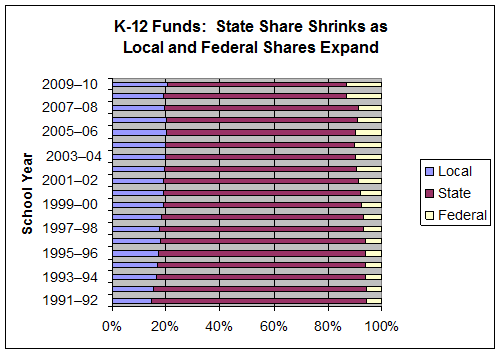This blog post was written by Barb Billinghurst for our edCored series on education funding. Barb is one of LEV’s Key Activists and school finance researcher. If you want to be notified when new content is published in this month-long series, please subscribe to the LEV Blog’s RSS feed or once-a-day email digest.
The 1889 framers of Washington state’s constitution made a promise to future generations when they wrote:
“It is the paramount duty of the state to make ample provision for the education of all children residing within its borders…”
The constitution has been interpreted by State Court judges in 1978 and 1983 to mean that the state must define and fully fund basic education. Further, the Court said the state cannot require districts to use local levies to fund basic education.
With such powerful words you would think that state dollars would figure prominently in the funding of K-12 education. And judging by the length of the red bars below, the state in fact has always funded the lion’s share in the last 19 years.

Source: Based on data from Table Two: Ten-Year Comparison of General Fund Revenues and Other Financing Sources per FTE Student in Section One of the State’s School District & ESD Financial Reporting Summary for various fiscal years.
But over time the state share has declined. Starting out at 78 percent in school year 1991-92, it fell to 65 percent in school year 2009-10.
Does the decline in state share signal a retreat from the state’s obligation to fund basic education?
 Yes, since 1994, the state’s contribution to total (from local, state, and federal sources) spending per student steadily lost ground against inflation as measured by the Seattle Consumer Price Index. To match the purchasing power of its contribution in 1994, the state would have to spend at least $200 more per student in school year 2009-10.
Yes, since 1994, the state’s contribution to total (from local, state, and federal sources) spending per student steadily lost ground against inflation as measured by the Seattle Consumer Price Index. To match the purchasing power of its contribution in 1994, the state would have to spend at least $200 more per student in school year 2009-10.
Meanwhile, the local share grew from 15 percent to 20 percent since school year 1991-92. Local levy funds have become essential to our children’s education.
In fact, superintendents, school board members and even OSPI officials have all testified that, despite state law, local levy dollars fund basic education.
Evidently, this is a practice that has gone on for some time.
As the Washington Association of School Administrators revealed in its 2007 Legislative Report:
Superintendents from districts large and small testified repeatedly that districts are facing a financial crisis primarily because they have to increasingly rely on local levy funding to make up the difference between what the state provides for basic education programs and what it costs to carry them out; to meet the needs for additional programs to bring all students up to state mandated standards; to fulfill collective bargaining agreements for non-state employees; and, to pay for unfunded mandates.
There could be no doubt that if the state properly funded basic education, levies would serve their original and important purpose. That is, they would provide flexibility for local communities to go beyond the basics to enrich their school programs, experiment and innovate, and tailor programs to local needs.
As cuts in state funding slice deeper, it’s no wonder we read stories of schools offering a stripped-down curriculum, devoid of the many amazing cultural, academic, and athletic experiences that we know have the power to light fires.
Just when we should be broadening our children’s horizons, we are instead narrowing them. A broken promise leaves our children the lesser for it.